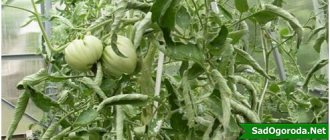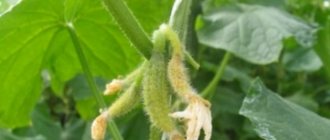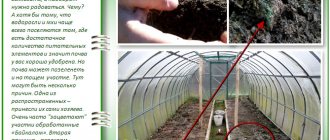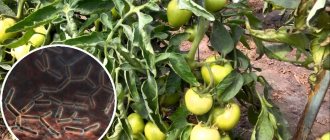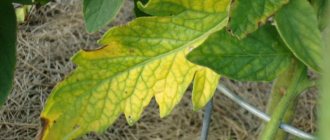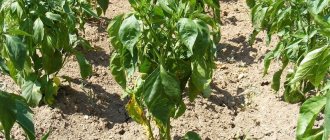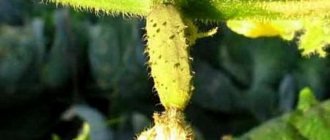Cucumbers are everyone’s favorite vegetable crop, which every family loves and grows in their dachas and gardens. Many dishes contain a tasty and healthy ingredient - a variety of salads and snacks with fresh, salted, pickled and pickled cucumbers. Without this vegetable it is impossible to imagine garden beds in the open ground or in a greenhouse.
By the way, greenhouses are a real salvation for delicate and fragile plants, because they protect them from strong gusts of wind, sudden cold snaps, direct sunlight, heavy rainfall and much more. But sometimes, even with such powerful protection, capricious cucumbers have problems with leaves and ovaries. The leaves suddenly begin to turn yellow and dry out, and the ovary falls off en masse. There can be many reasons for such negative changes.
Causes of yellowing leaves
Before starting to solve the problem, it is necessary to establish the cause of this phenomenon and review the rules for caring for plants. After all, if any disease develops, you need to act quickly so as not to lose the entire harvest.
The main factors that provoke the appearance of yellowness on the leaves:
- diseases and pests;
- insufficient lighting;
- unsuitable soil composition;
- violation of irrigation technology;
- poor pollination of bushes;
- temperature changes in the greenhouse;
- damage to the root system;
- sunburn;
- aging of foliage.
How to treat with drugs?
If folk remedies do not help, then use specialized drugs.
The most effective remedies for yellowing of cucumber leaves are Metronidazole and Fitosporin . Both drugs must be sprayed onto the plant. The proportions for preparing the composition are indicated on the packages. We advise you to follow the instructions so as not to harm the cucumbers even more.
Metronidazole
If yellowing has just begun, then you can try to save the plantings with potassium permanganate. To do this, you need to prepare a 1% solution and spray it on the affected leaves.
If you are sure that the cause of yellowing is a lack of nutrients, feed the bushes with a complex nitrogen-phosphorus-potassium fertilizer.
Planting density
If the plants are planted too densely, they become deficient in nutrients, which affects their appearance and can lead to the death of some bushes. The leaves begin to turn yellow and fall off.
The gardener needs to thin out the plants, remove some of the ovaries - no more than 25 inflorescences should remain on one vine. In this way, the normal development of the bushes is ensured, which guarantees a rich harvest.
Poor pollination
When grown in a greenhouse, preference should be given to parthenocarpic hybrids that do not require pollination. If you grow bee-pollinated varieties, as I wrote above, do not forget to plant honey plants nearby and arrange regular ventilation. Such preparations as “Bud”, “Ovary”, as well as a solution of boric acid will additionally help increase the formation of ovaries.
If, on the contrary, there are too many ovaries, remove some of the embryos (leave no more than 25). Otherwise, they will turn yellow and crumble.
Low air temperature
Cucumbers are heat-loving plants and are very susceptible to cold weather. If you ignore this rule and do not provide the plants with comfortable conditions, the consequences can be sad: yellow spots will appear on the leaves, which will gradually cover the entire leaf plate.
The problem can be eliminated using a special material (spunbond, agrotex), which must be used to cover the plants at night.
Why does the ovary dry out?
Yellowing of the lower leaf blades is not so bad. If the ovary and upper leaves turn yellow, it’s time to sound the alarm.
The main reasons for yellowing of the ovary are as follows:
- insufficient sunlight on the upper tier of the plant;
- exposure of bushes to low temperatures;
- lack of nitrogen and potassium in the soil.
Attention! It is very important for cucumbers to maintain temperature conditions.
Table. Optimal temperatures for growing cucumbers
| Growing period | Temperature, degrees C | |
| before fruiting | during the day | 21-24 |
| at night | 18 | |
| after entering fruiting | during the day | 23-27 |
| at night | 19 | |
Lack of moisture
Often the leaves of a crop in a greenhouse turn yellow due to non-compliance with watering rules. Cucumbers belong to the group of moisture-loving plants, which begin to get sick if there is a lack of moisture.
Too cold water is also not suitable for irrigation, since it causes the soil to cool, causing the leaf blades to turn yellow and the vines themselves to dry out. Cucumbers should be watered at the root, since water getting on the foliage can also lead to a change in color. The procedure is carried out in the absence of sunlight - late evening or early morning.
Interesting! Growing hydrangea in open ground in the Urals
Failure to comply with temperature conditions
Of course, no one can predict and fully prepare for all the weather surprises that nature presents to us. May 2022 was the coldest month in the entire history of weather observations (more than 100 years). June of the same year, although he did not become an absolute record holder, he confidently entered the top three.
The most dangerous are daytime overheating and nighttime cold snaps. For the growth and development of most parthenocarpic hybrids, daytime temperatures of +20 to +24 C and night temperatures of +16 to +18 C are well suited. At the time of active fruiting, daytime temperatures of +21 to +26 C and night temperatures of +21 to +26 C will be optimal. from +18 to +20 C. For bee-pollinated varieties, the above parameters should be increased by 1-3 C.
Soil temperature is very important for cucumbers. The optimal indicator is the range from +22 to +24 C. The critical point is in the range from +13 to +15 C.
Excess and deficiency of nutrients
Too much fertilizer can also negatively affect the development of cucumber seedlings, as can its lack. With excessive use of natural or chemical fertilizers, yellowness appears on the leaves, and the growth of the bush itself stops.
Cucumbers should be fed in the spring (once a month) and in the summer (2 times a month). The procedure is carried out with exact adherence to the dosage.
Formation of cucumbers in a greenhouse
How to pinch cucumbers correctly? Is it necessary to pinch cucumbers after the 4th leaf?
If these are hybrids (the seed bag will have the designation F1), then there is no need, since they immediately have female flowers on the main stem, which have a small cucumber.
If this is a variety, then it has mostly male flowers on the main stem. Female flowers are usually formed on side shoots. To speed up the appearance of side shoots with female flowers, the crown with the upper growth point is cut off, and then the bud closest to the growth point produces a side shoot.
It is usually recommended to cut off the crown (pinching) above the 4th leaf of the main stem. This first side shoot will later replace the torn central stem. Pinching further side shoots is done in the same way as for hybrids - after the 2nd leaf.
Pests
Cucumbers require regular and abundant watering, but high humidity combined with high temperature create favorable conditions for the development of pests. It is important to react in time and take the necessary measures, otherwise the foliage will begin to turn yellow and the plant will die very soon.
Root nematode
A fairly common problem, especially in areas where the soil has not been changed for a long time. The worms lay their eggs in the ground, and the rhizomes of cucumbers become the habitat of the larvae.
The presence of a nematode can be determined by characteristic swellings, after which the roots acquire a brown tint, become thick and fragile.
What to do: Regular renewal of the top layer (at least 10 cm) of soil will help, which should preferably be done annually. The proximity of cucumbers to radishes, cabbage and garlic will help get rid of nematodes - the pest does not like them.
Whitefly
The reason why cucumber leaves turn yellow in a greenhouse may be a whitefly invasion. Small butterflies of a gray, yellow or whitish hue resemble moths in appearance. Whitefly larvae feed on plant sap, and adults carry microorganisms that are dangerous to cucumbers on their wings.
What to do: in this case, it is necessary to block the pest’s access to the greenhouse - cover the windows and doors with gauze or mesh. If insects have already penetrated inside, they must be combated by hanging sticky tape near the bushes or making special traps.
Since the whitefly loves everything that is painted yellow, a gardener can take advantage of this by smearing a cardboard trap with glue. Among the chemical preparations, Fitoverm, Aktara, Aktellik are suitable.
Slugs
The presence of the pest is indicated by characteristic holes on the fruits. In good lighting, you can also see the silvery marks left by slugs.
What to do: insects move rather slowly, so hand collection is the most effective way. It is recommended to do this in the early hours, when slugs are less active. You can create an artificial barrier around cucumber seedlings from soda ash or sand with the addition of pine needles.
Among the drugs offered by the chemical industry, Slime Eater, Thunderstorm, and Meta are suitable for fighting slugs. But they should be used with caution and not used during flowering, ovary formation and fruiting.
The rules do not apply to biological means of protection (Strela, Iskra-Bio). A couple of days after using them, you can start harvesting.
melon aphid
Small green or yellowish insects attack the ovaries, buds and leaves of cucumbers, sucking the juice from them. Plants become deformed, stop growing and die.
What to do: you need to wash the lashes with soapy water. In case of mass damage, it is recommended to burn the diseased bushes and fumigate the rest with sulfur bombs.
Thrips
These are black midges with an elongated body, pointed at the end. The presence of insects can be detected by the beige-silver stripes that they leave on the back of the leaves.
What to do: in this case, blue sticky traps will help, as well as regular spraying with an odorous infusion. To prepare it, use orange peel, onion or garlic.
Wireworm
Wireworm larvae eat cucumber seeds embedded in the soil; they do not disdain the young roots of already formed bushes.
What to do: Fertilizers containing nitrogen will help destroy the worm. But you shouldn’t get carried away with them, since an excess of this element will lead to a deterioration in the quality of the crop. It is better to plant any legume crop next to the cucumbers, which will repel parasites.
Medvedka
The pest, which lives underground, gnaws through the roots of plants, causing the foliage to begin to turn yellow and dry out.
What to do: mechanical collection will be effective, as well as pouring sunflower oil and soap solution into the detected passages.
You can also make traps: place containers with corn or millet porridge. It’s better to plant marigolds next to the cucumbers - the pungent smell of the plants will repel the pest.
Reviews from experienced gardeners
Alina, 42 years old, St. Petersburg:
For a long time, my husband and I simply picked off the yellowed leaves, complaining about the sickness of the plants. Then my husband began to visit various forums and take a lot of advice from experienced gardeners. This brings results. Feeding and treating the plants did their job. Now the cucumber harvest is a joy for us and the envy of our neighbors.
Tatyana, 22 years old, Moscow:
Most often, our cucumbers in the greenhouse begin to feel unwell due to a lack of nitrogen. It is administered strictly following the dosage. Fertilizing has helped to get an excellent harvest for several years now. Treated leaves with soapy water in case of pest attack. He did his job very well.
Ostap, 37 years old, Astrakhan:
Mom always had excellent cucumbers in the greenhouse. Only natural preparations were used for feeding and processing. When planting, humus was first introduced, and then every month she added an ash solution. Many people are surprised how she manages to get such an excellent harvest without using chemicals, but my mother is adamant on this issue.
Timely care of cucumbers in a greenhouse will help you get a wonderful harvest. The main thing in this case is to do everything in a timely and correct manner. But you can read about the benefits of cucumbers and the most delicious recipes from this vegetable in our article HERE
Health to you and your loved ones! Natalya Belokopytova.
Diseases
Leaf blades may change color due to disease. Most often, cucumbers suffer from fusarium and pythiosis. These are fungal infections characterized by darkening and subsequently yellowing of foliage.
As a rule, the fungus appears after a sharp change in temperature, therefore, for the purpose of prevention, it is recommended to treat the seedlings with Fitosporin.
Interesting! Astilbe flower - planting and care
The leaf border or edge turns yellow
Yellowing of the leaf edge without the formation of yellow spots on the leaf blade itself indicates a lack of potassium.
Yellowing due to lack of microelements
What to do?
Feed the plant with potash fertilizers. It is best to use liquid preparations with a complex of useful elements.
Advice from gardeners
Experienced summer residents are ready to share tips on how to avoid yellowing of cucumber foliage when growing crops both in a greenhouse and in open ground:
- To normalize the climate, you can place a large dark container of water at the entrance to the greenhouse. During the day it will take part of the heat for itself, and at night it will heat the air.
- Fitoverm will help against spider mites. The drug is absolutely safe, and three days after treatment, the crop is ready for harvest.
- If the cause of yellowness is a lack of nutrients, use sifted ash (300 g) and dry mullein (200 g). Pour the components with water (10 l) and mix thoroughly, leave for a day. Feed the bushes at the rate of 1 liter of solution per plant. Carry out the treatment once a week.
As you can see, there are quite a few reasons why the leaves of cucumbers in a greenhouse turn yellow. And how to deal with this phenomenon depends on the problem. The expert advice presented above will help.
How to feed cucumbers so that the leaves do not turn yellow
Fertilizer for preserving green foliage and tops is prepared from ten liters of water and twenty milliliters of iodine. Before use, the solution is further diluted with water: for one part of the solution - ten parts of water.
When planting cucumber seedlings, two liters of herbal infusion with the addition of wood ash are added to each hole.
Before flowering, the bushes are sprayed with a solution of ten liters of water, one liter of fresh milk, a tablespoon of iodine and twenty milliliters of liquid laundry soap. Treatment can be repeated several times at intervals of ten to fifteen days.
To spray cucumbers at the beginning of flowering, prepare a solution from a large bucket of water, ten milliliters of brilliant green, two liters of whey or milk, fifty grams of urea. You can repeat the treatment of plants after seven to ten days.
The watering agent can be prepared from any weed. To do this, fill a large bucket two-thirds with grass, then fill it to the top with water and leave it in a warm room for a week. Before use, filter the solution and add water until the bucket is full.
- An infusion of rotted hay is prepared from equal parts of water and hay, infused for five to seven days, and filtered.
- Onion infusion for root and foliar use is prepared from ten liters of water and one liter of peel. The solution is boiled for one to two minutes and allowed to brew for 24 hours. Add four parts water to one part solution.
- Kefir solution for spraying is prepared from eight liters of water and two liters of kefir.
- Fertilizing with soda solution is prepared from a large bucket of water and two tablespoons of baking soda.
For watering and spraying, use a solution of ten liters of water, two liters of fresh whey and a cut glass of sugar. This is an effective remedy for the prevention of various diseases.
Top dressing that prevents cucumbers from turning yellow is prepared from water and wheat bread:
To one bucket of water add one loaf of bread, previously cut into small pieces, and leave for twelve hours to infuse, after which one teaspoon of iodine is poured into the mixture and the bread pieces are kneaded well. Before use, add ten liters of water to each liter of mixture. The finished product can be stored in the refrigerator in a tightly sealed container.
For watering at the root, prepare a solution from a bucket of water and three hundred grams of wood ash, leave it in a warm place to infuse. After three days, the infusion is ready for use. About five hundred milliliters are used per plant.
At the first signs of yellowing of the leaf part of the plants, a weak pink solution of potassium permanganate is added to the root of each bush.
